Water and Waste Water Plants Transform Using Web-Launched, Java-Based SCADA Software
Professionals in the water and waste water management field face a series of difficult challenges as they seek to stabilize and expand their service delivery capabilities, while at the same time meeting the regulatory reporting requirements of the state. As if that were not enough, they must accomplish this in the current economic environment facing local governments. Managers clearly need better ways of doing business and an economic model which will give them the functionality and scalability required at a price point that does not break the budget.
Presented here are the perspectives of three jurisdictions that have found a workable solution to address their needs. Brazeau County in the Province of Alberta Canada; the City of Lago Vista in Texas and the Helix Water District in California’s San Diego County.
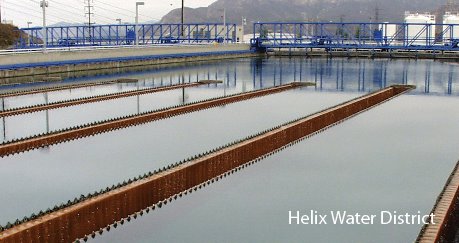
How It All Began
Steve Hechtman, the President and Founder of Inductive Automation Software, brings over 20 years experience as a systems integrator to the problem of managing water and waste water treatment plants. He shares his perspective on why he got into the software business and why it should matter to you:
“We needed a solution that allowed for PLC data to be readily available in SQL databases, that would not become obsolete every few years and which would provide an affordable expansion model for both run time and development needs. That was not available in the marketplace so I was forced into the software business.
“The first hurdle we put behind us was making PLC data readily available in SQL databases. From there we naturally started making reports and user interfaces using web pages. But it quickly became apparent we needed a rapid, standardized way of making such applications and of course security was a concern so we started investigating the various technologies available to do this.
“Ultimately, we decided to use Java for our platform, when virtually every other SCADA vendor chose the Microsoft route.”
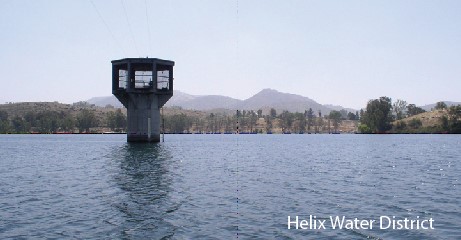
Why Choose Java?
“Proofing against obsolescence is one major consideration. Every five years Microsoft reinvents itself and in that act churns the very platform these other SCADA applications are built on. The cost to the water plant manager is often prohibitive with current traditional vendor licensing models.
“Cross-platform support is another consideration. Vista was having problems. Meanwhile Linux operating systems such as Ubuntu are free and are gaining ground fast around the world.
“Our Java application could care less what platform it runs on or what database it interacts with. It works comfortably with them all.
“So now, today, what do we have? We have the world’s only fully mature, cross-platform, web-launched, secure, reliable SCADA application server which can support any SQL database and which is very easy to use. A skilled integrator can set up an amazing SCADA application in about an hour and then proceed from there to launch five or fifty clients anywhere, totally securely.”
The benefits to the water and waste water plant manager or supervisor will be obvious as you read the case studies and thoughts of Rick Flikkema from Brazeau County, Alberta; M.J. Duke from the City of Lago Vista and Henry Palachek, the Information and Process Control Systems Supervisor from the Helix Water District in San Diego.
Brazeau County, Alberta, Canada
Clearly, every municipality has a water and waste water department. The people who work in these departments are responsible for maintaining water quality delivered to their constituents as well as the delivery system itself. Well pumps and HighLift pumps are typically employed to move the water from the inside the earth or from reservoirs to fill the miles of pipes that go to each home and business to supply fresh potable water. On the output end, the systems have to treat contaminated water and remove the waste.
Typically these departments rely on the expertise of a system integrator (SI) or a consultant to guide them in their technological quests.
The county of Brazeau is located north-west of Calgary, Alberta in the Canadian Rockies. They needed to upgrade their Texas Instruments PLCs and chose to go with KSB Industrial (KSBI) as the SI.
Ken Bannard, President of KSBI, used GE PLCs for the Brazeau county new technology platform. These two PLCs are connected to the main office by leased lines using 9600 baud modems. Along with the new platform, KSBI implemented new SCADA software as well.
FactoryPMI from Inductive Automation was selected as the ideal software for this implementation. Rick Flikkema operates the two water plants and the three lift stations for the county.
“FactoryPMI has eased up alot of my time,” Rick said. “I was skeptical at first, when Ken introduced me to FactoryPMI.”
Over time Ken showed Rick how it would save the county money and time. “FactoryPMI is very cost-effective solution. Our end users become very interested when they hear that they can have unlimited clients at no extra cost,” Ken said.
Most municipalities are on a reduced budget and have fewer resources available to them. FactoryPMI makes up for those ‘losses’.
“FactoryPMI is both the development system and runtime. My customer has the ability to have anyone make changes if needed,” said Bannard. “And with the VPN remote access ability, a web access license doesn’t need to be purchased, unlike most other SCADA products.”
For the county of Brazeau, the total cost of ownership is hugely attractive. They have one server for control, monitoring and data tracking of the two water plants and lift stations.
“FactoryPMI has been running for 24 months trouble-free. It has made my job easier because I can monitor all areas of operation efficiently,” said Rick.
For the county of Brazeau, when they move towards additional reporting and data logging as well as a third water plant, their upfront costs will be negligible. “The upgrade path is very easy and inexpensive,” remarked Bannard. “FactoryPMI is good for integrators since it empowers them on behalf of their customers. The no-limit tag count allows me to provide the best possible system for my customer with minimal capital outlay.”
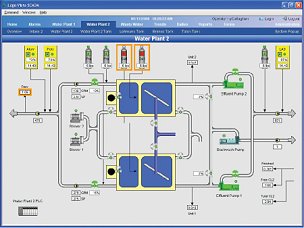
Realtime Status and Control Overview
City of Lago Vista Water and Waste Water Facilities
Deep in the heart of Texas, there is a city of approximately 6,000 people called Lago Vista. Located just west of Austin, there are many qualified system integrators nearby.
Patrick Callaghan from MCS Integrations was selected as the SI to assist Lago Vista with their SCADA upgrade path. M.J. Duke, Superintendent of Plant Operations for the district explains why: “Pat does his homework and is very thorough. If Pat likes it, then I like it!”
And Pat likes FactoryPMI from Inductive Automation.
Lago Vista often had issues with their previous software; and the common answer to many questions was “We just can’t do that.” And if there was a way, it was often too costly to implement.
Like most integrators, Callaghan mainly used one of the ‘big three’, and typically used Wonderware’s Intouch HMI software. “With what we have accomplished using the stock FactoryPMI software, I would have had to write custom code [with Wonderware],” indicated Callaghan.
Inductive Automation’s licensing model made the decision easy. “We were operating on stand-alone systems, and wanted to move towards a centralized system,” said Duke. “Runtime licensing with our former supplier was an issue. The upfront license costs for the new system were one-fifth what it would have cost using Wonderware,” stated Callaghan.
Duke oversees the operation of two water plants and the waste water facilities. There are six distribution pump stations remote to the main plants, as well as two intake stations all having Automation Direct PLC technology. There are also four holding ponds which require monitoring. And soon, Lago Vista will add an irrigation system for a city-owned golf course which will also need control and monitoring.
MCS Integrations began the migration by consolidating the existing applications into one FactoryPMI server-based application. After adding all the functionality available before the migration, the city was able to add additional functionality which wasn’t previously possible. “There were no holes in the conversion,” Callaghan said. “There was a learning curve in the beginning – my database experience was small. But Inductive Automation’s new SQLTags technology was a blessing.”
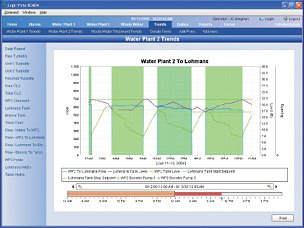
Graph Screen Showing History of Turbidity, Tank Level, Flows, etc.
The former HMI/SCADA system had stand-alone applications running in each different location. In order to monitor the operations, the operators needed to drive to individual locations. While the efficiency of the department wasn’t ideal, it was rapidly deteriorating as the cost of operator travel increased.
Callaghan installed a FactoryPMI server at the primary water plant (WP1). Plant-to-plant communications were established with fiber optics. VHF communications connect the remote
PLCs to the system network. As well, there are client workstations in each plant. The router at WP1 connects to the Internet to allow for remote VPN access. Each plant also has a Wi-Fi access point.
Lago Vista wanted to be able to access all systems from each plant, as well as from mobile tablets, which they can now do. “When the operators are in their trucks, they can use the tablet PCs to access the network,” Duke said. They use a Bluetooth-enabled cell phone for internet connectivity and then create a VPN connection through the Internet to the router located at WP1.
All forms the operators need are embedded into the FactoryPMI system. The operators can input data in real-time, speeding up some compliance requirements. “No more driving to get data. They used to enter data on paper on a clipboard,” said Duke. “We looked into using Palm Pilot type devices before, but we wouldn’t be able to get the amount of data onto the screen that we needed. Without the tablets and system coverage, our response to issues would be way too slow.”
The department has to provide 24/7 service, so the mobile tablets and the ability to access the systems from any location means very fast response. “The FactoryPMI server will send an email alarm-notification to the cell phone of the person on call,” says Callaghan. The operator can then log-on to the FactoryPMI server and figure out what the issues might be. “This has increased our efficiencies,” stated Duke.
The operators can also do process checks at night, which can catch problems before they escalate. “Equipment failure can be circumvented,” says Callaghan.
Compliance regulations require city water departments to log and track data on all aspects of water plants and waste water facilities. This is done to ensure municipal compliance with the law, and ensure required levels are maintained (such as of chlorine).
Callaghan says, “Data logging with FactoryPMI is really easy. Logging this much data with Wonderware would have been much more difficult and costly. We have over 3,000 tags. Every day there is something different to add – with direct data entry and SQL—voila!”
There was some hand-holding at the beginning of the project due to Callaghan’s lack of database experience. “The support from Inductive Automation was immediate when required,” Callaghan said. He observes that what the project now entails could not be easily replicated using another HMI product. In fact, he wonders if it would be possible at all without a lot of custom code. There is no doubt that—regardless of which product it might be—it would cost more and take longer.
Callaghan concludes “FactoryPMI is a non-proprietary solution and uses standard platforms. The scripting language is very powerful (Python for Java). It’s a fabulous product!”
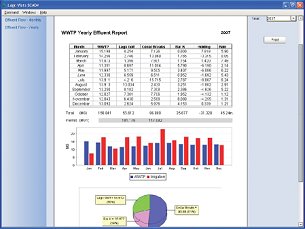
A Year’s Worth of Data in a PDF Document
An interview with Helix Water District’s Henry Palachek
Information and Process Control Systems Supervisor
Henry Palachek has been with the Helix Water District for the past fifteen years. He serves as the Information and Process Control Systems Supervisor. Inductive Automation (IA) caught up with him to get his views on the value of implementing web-launched and database centric SCADA software in meeting the challenges he faces supervising the water and waste water systems for the Helix Water District.
What is the biggest challenge you face with your job?
The way in which SCADA systems age and how it is related to the operating system they work on is a big challenge for us particularly right now.
With the current SCADA system and how traditional SCADA software products work, you are not certified to run on Vista. You are then forced to upgrade your system because you are only certified to work on Windows 2000 or XP II and if those are going away then the cost of upgrading the SCADA system becomes too much.
This means that obsolescence becomes a big problem with traditional SCADA software products.
When software is created based on working directly with the DB, which is what Inductive Automation has done with FactorySQL, you get a longer life span for the system. The life span goes to 10-13 years. Obsolescence and cost prohibitive upgrade cycles then are not a problem.
How does Inductive Automation’s FactorySQL assist you with California state reporting requirements?
The Surface Water Treatment Rule for California requires monitoring filters’ turbidity and reporting that to the state on set intervals. So having a software package that allows for talking directly to the field controller is a great advantage.
Helix has 50 sq. mile distribution system and 260,000 customers. The Distribution Manager logs the data to the database on 5 minute intervals. We have then set up stored procedures that create hourly and daily summary data.
This then gives us the ability to create reports which we can mail directly to the state for complying easily with the Surface Water Treatment Rule.
We have had InTouch for over 10 years. Classic SCADA packages don’t have an easy way to do that. The drag and drop ease of use of FactorySQL is great for these reporting requirements.
Ease of use, learning curve and set up time are important factors. Has IA software measured up in that area?
Absolutely, I had it set up on my notebook in about half an hour. With a classical Wonderware package it is cumbersome if you do DB. It requires multiple steps to configure. With FactorySQL it is like one step configuration. You put in a tag name and drag the tag name and drop to the bottom to create a table and start logging. It is like night and day difference.
How did you make a decision to go with Inductive Automation software?
I went out and looked at all the leading vendors; none of them had the same ease of use with the drag and drop feature.
We have had no issues with reliability or uptime.
Plus there is a big advantage if a computer fails. With traditional systems you have to rebuild the computer and then get SCADA system back on it with whatever patches or upgrades you may have. It can cost time and money and lost data. With FactorySQL you can take any PC almost out of the box and get it easily up and running. This will help you solve hardware problems a lot faster.
It is a nice feature to have unlimited tags and to not have to buy a license for unlimited tags and not to worry about how many tags I do have.
Is there a cost advantage?
We’re running 16 SCADA clients in our treatment plant. When you start adding up 16 licenses just so our operators can view and acknowledge alarms, it starts getting pretty expensive.
The cost of just a single license for development or runtime with traditional software vendors can be about $5,000 to $12,000. So you certainly do have a cost advantage with FactorySQL and FactoryPMI, as the license is sold by the server and provides unlimited tags and unlimited clients to us as the customer.
If you are doing a SCADA change out with a large number of clients price does become an issue.
Any final thoughts for our readers?
In the water utility field there is a lot more pressure than there used to be in three areas:
1. Regulation requirements—Working with a database-centric product helps with regulatory issues.
2. Economic issues—It is not just business as usual. You really have to look at the cost of the system and FactoryPMI and FactorySQL have a definite advantage there.
3. Managers need better ways of doing business—Web technology with SQL databases is really a better way of doing business.








0 Comments:
Post a Comment